Tips and Tricks
Ezio Lanza MD
Today I am going to give you an overview on the different applications of Glubran®2, through some case reports in both elective and emergency settings.
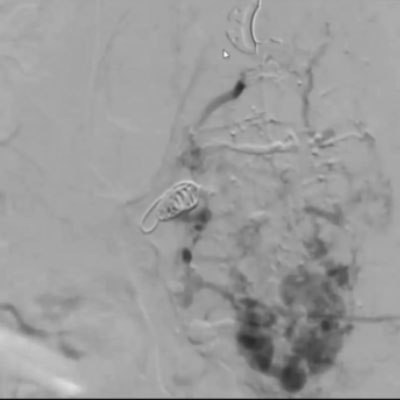
CASE 1 – Gluteal AVM
Woman (50) – 1:4 ratio small “sandwich” boluses
We injected small boluses of mildly diluted glue, using a very small syringe (1ml), alternated with small amounts of glucose, in order to obtain a widespread distribution of the glue without sacrificing the micro-catheter. As you know, these cases require multiple interventions, and the goal is, of course, to maximize embolization in each session, while avoiding severe ischemia. The end result is that the upper part of the AVM has been successfully devascularized, while the lower part will be treated in a subsequent procedure.
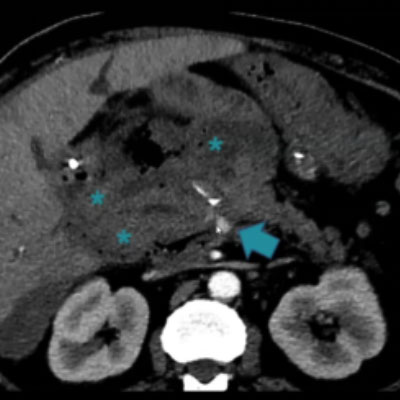
CASE 2 – Coeliac Pseudoaneurysm from Superior Mesenteric after Pancreaticoduodenectomy
Man (59) – 1:3 ratio – 0.1 ml focal injection to avoid non-target embolization
In this case, I want to show you which are the metrics we have to get used to when we approach the use of cyanoacrylates: 0.1ml of glue is a reasonable amount and we need to get to terms with the fact that sometimes this is all we need when we are trying to avoid non-target embolization. In this case, we have a large coeliac hematoma and a pseudoaneurysm, which is active bleeding from the superior mesenteric artery. This may happen because, as you know, pancreaticoduodenectomy is a very invasive procedure. The difficulty here is that the pseudoaneurysm is pointing upwards in respect to the artery, so the catheterization was quite challenging, however once I managed to place the micro-catheter, the only thing left to do was to inject 0.1ml of glue to create some sort of a balloon, so to completely exclude the pseudoaneurysm.
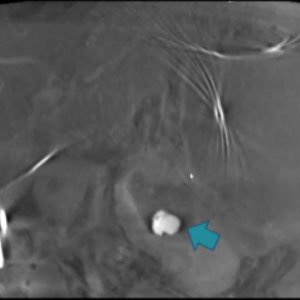
CASE 3 – Gastric artery bleeding after pancreaticoduodenectomy
Man (80) – 0.15 ml superselective injection – 1:5 ratio
This was a large bleeding from the gastric artery and this patient’s haemoglobin levels were rapidly dropping. As you can imagine, in this case, embolizing agents other than liquid would be very difficult to deploy. Medium range of dilution, as 1:4/1:5, allowed for a good deployment of the glue inside the lumen of the bleeding bowel, while achieving the embolization of the vessel to successfully stop the bleeding.
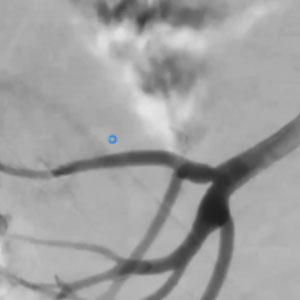
CASE 4 -Adrenal Mass Bleeding
0.1 ml Glubran®2 – 1:3 ratio
This was a very unusual case of adrenal artery bleeding due to a tumour, which was causing a slow decrease of haemoglobin levels. Again, selective catheterization and a very small amount of glue – though in a much denser concentration – allowed to easily stop the bleeding.
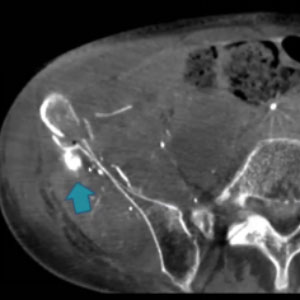
CASE 5 -Iliac Bone Comminuted Fracture after RTA
Woman (72) – 1:9 ratio to reach multiple bleeding sites
This time we have a very different case, where we adopted a more diluted ratio in order to reach multiple, fast bleeding sites, with a single embolization. This diluted mixture allowed for quick, full and effective embolization of the bleeding spots.
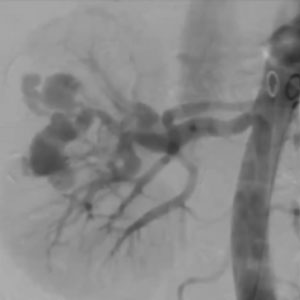
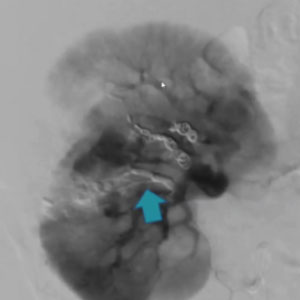
CASE 6 – Robotic Kidney Surgery “when coiling is not enough”
Man (54) – 1:9 ratio – slow controlled injection
We do not normally use glue when it comes to the kidneys because it is a terminal vascularization, but when coiling is not enough you may need different embolic material. This was a particularly difficult case as it presented multiple bleeding, and it just would not stop with simple coiling of the arteries, so I decided to switch to glue. It was important to handle the syringe with care because, when you deal with terminal arteries, it is very easy to get backflow. I used a sandwich technique with a very diluted mixture, inserting small boluses from the tip of the micro-catheter inside the cavity formed by the surgery and the hemorrhage. By handling the syringe with care I was able to inject a block of glue that formed sort of a film from which I could build up and successfully managed to completely embolize the vessel, while avoiding backflow. I could still see some residual bleeding from the coiling technique I had used before, and, although I was confident it would stop sooner or later, which it eventually did, I believe that if I had started with glue rather than coiling, I could have reached the goal much faster.
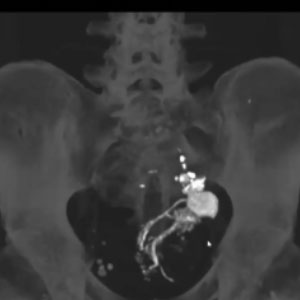
CASE 7 -Pelvic CHO type 2 AVM – Large venous backflow
Man (54) – 1:4 ratio Glubran®2 + Amplatzer plug
This was a very unusual and challenging case: a large pelvic malformation with an aneurysmal venous sac. Dario and I got a bit creative and performed a double puncture in order to place three catheters: one inside the artery feeding the AVM, and two inside the draining vein. From the first, we started deploying a 22 mm type 3 Amplatzer plug – to stop the backflow and avoid a pulmonary embolism, – followed by our mixture. The plug successfully stopped the glue, and this allowed us to fill the aneurysmal sac. The final result was very satisfactory and the patient made a complete recovery.
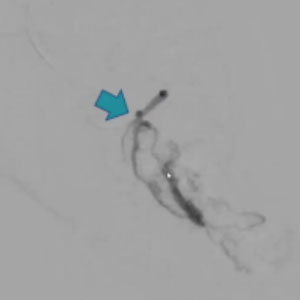
CASE 8 – Forefoot AVM
Woman (35) – 0.1 ml Glubran®2 – 1:3 in the posterior tibial
In this case, we applied manual compression of the digital arteries in order to avoid embolization and stop the flow. Again, we used only a small amount of glue, in a highly dense ratio, and the final result was completely satisfactory, with preservation of the digital arteries and no signs of ischemia.
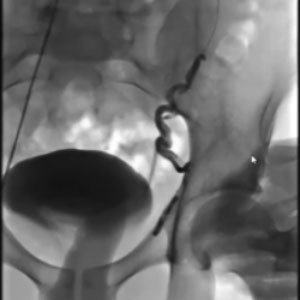
CASE 9 – Varicocele Embolization
Man (20) – 3 ml of Glubran®2 – 1:2 ratio
This was a case of very difficult anatomy, as we are talking about many different veins and collaterals, and I could not place the micro-catheter where I wanted to, so my stance was very proximal. I used a very dense mixture while asking the patient to do a strong Valsalva manoeuvre and apply manual compression of the left groin. Using this trick I was able to achieve distal embolization while not being distal at all. The final result was very good and we saw no further complications.




